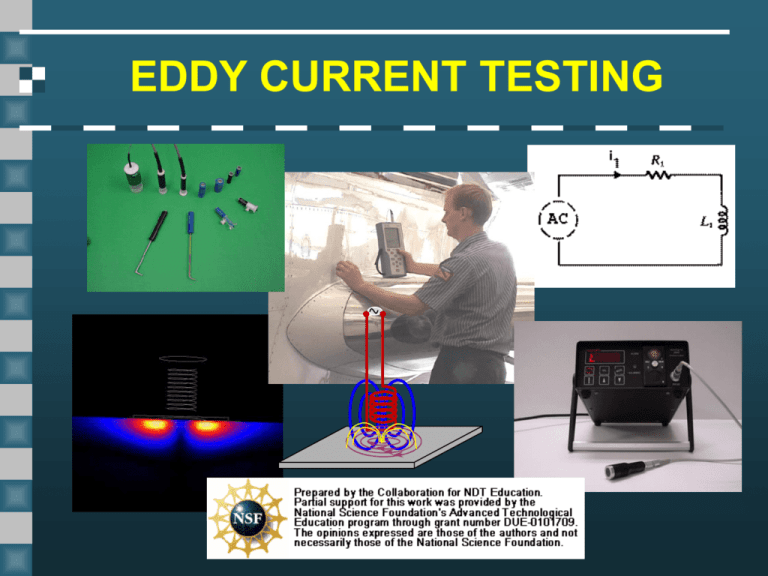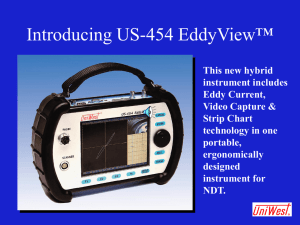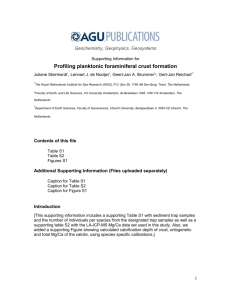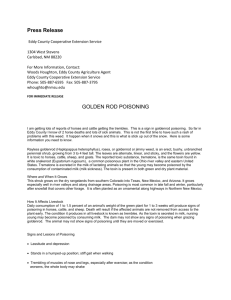Intro_to_Eddy_Current
advertisement

EDDY CURRENT TESTING Introduction This module is intended to present information on the NDT method of eddy current inspection. Eddy current inspection is one of several methods that use the principal of “electromagnetism” as the basis for conducting examinations. Several other methods such as Remote Field Testing (RFT), Flux Leakage and Barkhausen Noise also use this principle. Outline Electromagnetic induction Generation of eddy currents Inspection applications Equipment utilized in eddy current inspection Probes/Coils Instrumentation Reference standard Advantages and Limitations Glossary of Terms Electromagnetic Induction Eddy currents are created through a process called electromagnetic induction. When alternating current is applied to the conductor, such as copper wire, a magnetic field develops in and around the conductor. This magnetic field expands as the alternating current rises to maximum and collapses as the current is reduced to zero. Electromagnetic Induction (cont.) If another electrical conductor is brought into the proximity of this changing magnetic field, the reverse effect will occur. Magnetic field cutting through the second conductor will cause an “induced” current to flow in this second conductor. Eddy currents are a form of induced currents! Current Flow Generation of Eddy Currents Eddy currents are induced electrical currents that flow in a circular path. They get their name from “eddies” that are formed when a liquid or gas flows in a circular path around obstacles when conditions are right. Test Probe Eddy Currents Generation of Eddy Currents (cont.) In order to generate eddy currents for an inspection a “probe” is used. Inside the probe is a length of electrical conductor which is formed into a coil. Generation of Eddy Currents (cont.) Alternating current is allowed to flow in the coil at a frequency chosen by the technician for the type of test involved. Generation of Eddy Currents (cont.) A dynamic expanding and collapsing magnetic field forms in and around the coil as the alternating current flows through the coil. Generation of Eddy Currents (cont.) When an electrically conductive material is placed in the coil’s dynamic magnetic field electromagnetic, induction will occur and eddy currents will be induced in the material. Generation of Eddy Currents (cont.) Eddy currents flowing in the material will generate their own “secondary” magnetic field which will oppose the coil’s “primary” magnetic field. Generation of Eddy Currents (cont.) This entire electromagnetic induction process to produce eddy currents may occur from several hundred to several million times each second depending upon inspection frequency. Generation of Eddy Currents (cont.) Eddy currents are strongest at the surface of the material and decrease in strength below the surface. The depth that the eddy currents are only 37% as strong as they are on the surface is known as the standard depth of penetration or skin depth. This depth changes with probe frequency, material conductivity and permeability. Depth Depth Standard Depth of Penetration (Skin Depth) 1/e or 37 % of surface density Eddy Current Density High Frequency High Conductivity High Permeability Eddy Current Density Low Frequency Low Conductivity Low Permeability Inspection Data There are three characteristics of the specimen that affect the strength of the induced eddy currents. – The electrical conductivity of the material – The magnetic permeability of the material – The amount of solid material in the vicinity of the test coil. Information about the strength of the eddy currents within the specimen is determined by monitoring changes in voltage and/or current that occur in the coil. The strength of the eddy currents changes the electrical impedance (Z) of the coil. Inspection Data (cont.) Impedance (Z) in an eddy current coil is the total opposition to current flow. In a coil, Z is made up of resistance (R) and inductive reactance (XL). ~ R XL Test Coil Definitions: • Resistance - The opposition of current flow, resulting in a change of electrical energy into heat or another form of energy. • Inductive Reactance (XL) - Resistance to AC current flow resulting from electromagnetic induction in the coil. • Impedance (Z) - The combined opposition to current flow resulting from inductive reactance and resistance. In an AC coil, induction from the magnetic field of one loop of the coil causes a secondary current in all other loops. The secondary current opposes the primary current. Inspection Applications One of the major advantages of eddy current as an NDT tool is the variety of inspections that can be performed. The following slides depict some of the these capabilities. Material Thickness Measurement Thickness measurements are possible with eddy current inspection within certain limitations. Only a certain amount of eddy currents can form in a given volume of material. Therefore, thicker materials will support more eddy currents than thinner materials. The strength (amount) of eddy currents can be measured and related to the material thickness. Magnetic Field From Probe Test Material Eddy Currents Material Thickness Measurement (cont.) Eddy current inspection is often used in the aviation industries to detect material loss due to corrosion and erosion. Material Thickness Measurement (cont.) Eddy current inspection is used extensively to inspect tubing at power generation and petrochemical facilities for corrosion and erosion. Crack Detection Crack detection is one of the primary uses of eddy current inspection. Cracks cause a disruption in the circular flow patterns of the eddy currents and weaken their strength. This change in strength at the crack location can be detected. Magnetic Field From Test Coil Magnetic Field From Eddy Currents Crack Eddy Currents Crack Detection (cont.) Eddy current inspection is exceptionally well suited for the detection of cracks, with an especially high sensitivity to detection of surface breaking cracks. Crack Detection (cont.) Eddy current inspection of “bead seat” area on aircraft wheel for cracks using special probe that conforms to the shape of the rim. Crack Detection (cont.) Loading points, such as fastener holes, are high stress areas and often the site of service induced fatigue cracking. Rotating probe guns can be used to inspect a large number of holes in a short period of time. The photo on the right is a waterfall plot of the cross section of a fastener hole. Each horizontal line represents one rotation of the probe gun. A vertical signal indicates a crack. Nonconductive Coating Measurement Nonconductive coatings on electrically conductive substrates can be measured very accurately with eddy current inspection. (Accuracy of less that one mil is not uncommon.) The coating displaces the eddy current probe from the conductive base material and this weaken the strength of the eddy currents. This reduction in strength can be measured and related to coating thickness. Nonconductive Coating Conductive Base Metal Eddy Currents Nonconductive Coating Measurement (cont.) The photo to the left shows an aircraft panel paint thickness inspection. On the right, the display of a digital eddy current inspection instrument shows the different signals obtained by measuring eight different thicknesses of paint on aluminum. Increasing paint thickness Monitoring Conductivity and Permeability Variations Eddy current inspection is sensitive to changes in a material’s electrical conductivity and magnetic permeability. This “sensitivity” allows the inspection method to be used for such inspection procedures as: • Material Identification • Material Sorting • Determination of heat damage • Cladding and plating thickness measurement • Heat treatment monitoring Conductivity Measurements Boeing employees in Philadelphia were given the privilege of evaluating the Liberty Bell for damage using NDT techniques. Eddy current methods were used to measure the electrical conductivity of the Bell's bronze casing at a various points to evaluate its uniformity. Equipment Equipment for eddy current inspection is very diversified. Proper equipment selection is important if accurate inspection data is desired for a particular application. As a minimum, at least three basic pieces of equipment are needed for any eddy current examination: – Instrumentation – Probes – Reference Standards Instrumentation - Meters Meters are typically the simplest form of eddy current instrumentation. The two general categories of meters are digital and analog. Digital Meters Digital meters are typically designed to examine one specific attribute of a test component such as conductivity or nonconductive coating thickness. These meters tend to have slightly higher accuracy than analog devices. Analog Meters Analog meters can be used for many different inspection applications such as crack detection, material thickness measurements, nonconductive coating measurements or conductive coating measurements. Analog Meters (cont.) The display read-out found on most analog instruments is typically either a calibrated or uncalibrated display. • Calibrated displays have an inherent scaling factor which correlates to the property the instrument is designed to measure such as conductivity. • Uncalibrated displays are typically more flexible in the variety of different tests they can perform. These types of instruments, however, require the use of data extrapolation techniques if quantitative data is desired. Portable Eddy Scopes Portable Eddy Scopes (cont.) Portable eddy scopes are another category of instrumentation and they present the inspection data in the form of an impedance plane diagram. • On the impedance diagram, the total impedance is displayed by plotting its resistance component and inductive reactance component at 90 degrees to each other. • This is beneficial for both separation and identification of test variables that can effect inspection results. Portable Eddy Scopes (cont.) Modern eddy scopes are usually digital based instruments which can often be purchased as either a single or dual frequency tester. Dual frequency instruments are capable of sequentially driving a probe at two different inspection frequencies. Portable Eddy Scopes (cont.) Digital scopes often have an RS232 (serial) connection for interfacing with a serial printer or computer as well as provisions for output of signals to recording devices such as a strip-chart recorder. In addition, these instruments contain a small amount of RAM so that equipment settings as well as screen presentations can be stored for later reference. Multi-Frequency Eddy Current Instruments Multi-Frequency Eddy Current Instruments (cont.) • • • Multi-Frequency instruments usually refer to equipment that can drive inspection coils at more than two frequencies either sequentially (multiplexing) or simultaneously. This type of instrumentation is used extensively for tubing inspection in the power generation, chemical and petrochemical industries. These instruments are often capable of being computer networked and may have as many as four probes attached to them at one time. Multi-Frequency Eddy Current Instruments (cont.) Advantages of Multi-frequency inspections: Allows increased inspection information to be collected from one probe pulling. Provides for comparison of same discontinuity signal at different frequencies. Allows mixing of frequencies which helps to reduce or eliminate sources of noise. Often improves detection, interpretation and sizing capabilities of discontinuities. Multi-Frequency Eddy Current Instruments (cont.) Screen of multi-frequency instrument during inspection. Eddy Current Probes Eddy Current Probes (cont.) • • Probes selection is critical to acquiring adequate inspection data. Several factors to consider include: – Material penetration requirements (surface vs. subsurface) – Sensitivity requirements – Type of probe connections on eddy current instrument (many variations) – Probe and instrument impedance matching (will probe work with instrument) – Probe size (smaller probes penetrate less) – Probe type (absolute, differential, reflection or hybrid) Eddy Current Probes (cont.) • • Due the the large variety of probes in eddy current testing there are many different systems of classification. Three of the most common classifications are: – Surface probes – Inside Diameter (I.D.) or Bobbin Probes – Outside Diameter (O.D.) or Encircling probes Eddy Current Probes (cont.) Surface probes are coils that are typically mounted close to one end of a plastic housing. As the name implies, the technician moves the coil end of the probe over the surface of the test component. Eddy Current Probes (cont.) Some surface probes are specifically designed for crack detection of fastener holes. These include sliding probes, ring probes and hole probes. Eddy Current Probes (cont.) Surface probes can be very small in size to allow accessibility to confined areas. Finger Probe Eddy Current Probes (cont.) Inside Diameter (I.D.) probes, also known as bobbin probes, are coils that are usually wound circumferentially around a plastic housing. These probes are primarily designed for inspection inside of tubular materials. Eddy Current Probes (cont.) Outside Diameter (O.D.) probes are coils that are wound the circumference of a hollow fixture. The coil is designed such that the test part is ran through the middle of the coil. These probes can be used to inspect bars, rods as well as tubes. Reference Standards Reference Standards (cont.) • • • • In order to give the eddy current inspector useful data while conducting an inspection, signals generated from the test specimen must be compared with known values. Reference standards are typically manufactured from the same or very similar material as the test specimen. Many different types of standards exist for due to the variety of eddy current inspections performed. The following slides provide examples of specific types of standards. Reference Standards (cont.) Material thickness standards used to help determine such things as material thinning caused by corrosion or erosion. Reference Standards (cont.) Crack Standards: Reference Standards (cont.) ASME Tubing Pit Standard: Reference Standards (cont.) Nonconductive coating (paint) standard with various thickness of paint on aluminum substrate. Advantages of Eddy Current Inspection • Sensitive to small cracks and other defects • Detects surface and near surface defects • Inspection gives immediate results • Equipment is very portable • Method can be used for much more than flaw detection • Minimum part preparation is required • Test probe does not need to contact the part • Inspects complex shapes and sizes of conductive materials Limitations of Eddy Current Inspection • Only conductive materials can be inspected • Surface must be accessible to the probe • Skill and training required is more extensive than other techniques • Surface finish and and roughness may interfere • Reference standards needed for setup • Depth of penetration is limited • Flaws such as delaminations that lie parallel to the probe coil winding and probe scan direction are undetectable Glossary of Terms • • • Alternating Current: electrical current that regularly reverses direction. Analog: being or relating to a mechanism in which data is represented by continuously variable physical quantities such as a watch with hour and minute hands. ASME: acronym for American Society of Mechanical Engineers. This society is highly involved in establishing and maintaining industrial standards. Glossary of Terms • • • • • CRT: acronym for Cathode Ray Tube. Vacuum tube that uses one or more electron guns for generating an image. Calibration: adjustment of a test systems response using known values so that unknown quantities may be derived. Conductor: material capable of allowing electrical current to flow through it. Discontinuity: an interruption in the physical structure of a part. Cracks are examples of discontinuities. EDM: acronym for Electrical Discharge Machine. Glossary of Terms • • • EDM: acronym for Electrical Discharge Machine. Machining technique which uses an electrode and electrical current to remove metal. Sometimes used to prepare calibration standards for eddy current testing. Electromagnetic Induction: process which creates electrical current flow when a dynamic magnetic field is brought into close proximity with an electrical conductor. Extrapolation: to project or predict unknown values from know quantities. Glossary of Terms • • • I.A.C.S.: acronym for International Annealed Copper Standard. Standard unit of measurement of electrical conductivity in eddy current testing with pure annealed copper as the standard, measuring 100% at 20 degrees Celsius. Impedance Plane Diagram: A diagram that depicts the changes in electrical impedance that occur in an eddy current coil as test variables change. Multiplexing: use of a time sharing system in which a coil is stimulated at several different frequencies one after another for a certain amount of time. Results from each stimulation can then be processed and displayed. Glossary of Terms • • • Permeability: the ease with which a material can be magnetized. Probe: common term used in eddy current inspection that refers to the test coil. RAM: acronym for Random Access Memory. Most modern eddy current instruments have some form of memory used as a data buffer to store information.





